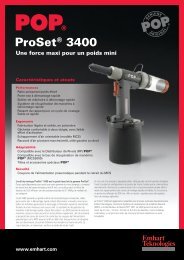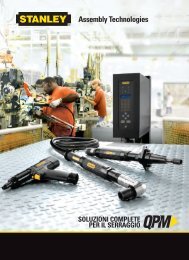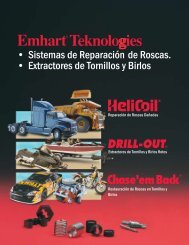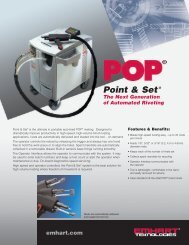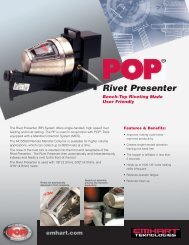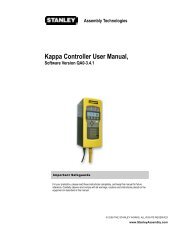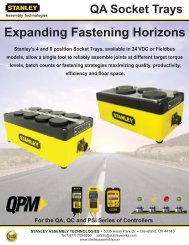PSI-C/C2 Controller - Automated Fastening Equipment
PSI-C/C2 Controller - Automated Fastening Equipment
PSI-C/C2 Controller - Automated Fastening Equipment
You also want an ePaper? Increase the reach of your titles
YUMPU automatically turns print PDFs into web optimized ePapers that Google loves.
<strong>PSI</strong>-C <strong>Controller</strong><br />
NOTE:<br />
Any added square drive extension, including a rotary transducer, causes efficiency loss and thus<br />
torque loss at the fastener. Use only eCoDrive sockets and extensions for maximum efficiency.<br />
2.5.8.2 Set-up Problems<br />
The inability for the controller or tool to set up correctly may be due to too a bad cable connection<br />
or wiring within the tool to the connector. This may be indicated by the controller screen reading<br />
XDUCER FAIL or CALIBRATION FAILED. Check cable connections at the <strong>PSI</strong>-C and at the<br />
tool. Change the cable if this does not correct the fault.<br />
2.5.8.3 Other Concerns<br />
2.5.8.3.1 Tool Air Hose Length<br />
The <strong>PSI</strong>-C is designed to operate a tool with an 8’ - 25’ long, 3/8” inside diameter air hose.<br />
However, the controller adjusts to any reasonable hose length, provided that the pressure drop and<br />
restrictions do not affect the airflow volume. With a longer hose, the system may require a longer<br />
dwell time between fasteners. See CYCLE DELAY under ADMIN functions. If the tool is<br />
changed, the torque should be checked and the system calibrated with the new tool to ensure<br />
proper function.<br />
2.5.8.3.2 Air Pressure and Volume<br />
Clean air at 90 psi with sufficient air volume is required in cases where the tool is being used at or<br />
above 90% of its rated capacity. The air pressure required for a particular application varies<br />
depending on the tool and the torque required. If the tool is used at >90% of its specified output,<br />
then the available air pressure is critical in order to achieve torque. If the <strong>PSI</strong>-C setup requires 75<br />
<strong>PSI</strong> to achieve torque with a particular tool, then the input air pressure to the controller must not<br />
fall below 75 <strong>PSI</strong> when the tool is pulsing (or coming to final torque). If the facilities air pressure<br />
falls more than 10 <strong>PSI</strong> from static reading when a tool is free-running, then the plant air volume<br />
may not be sufficient for the application and a tool with more torque capacity may be required.<br />
2.5.8.3.3 Excessive Cycle Time<br />
If torque scatter is excessive, or the cycle time is too long, suspect the socket and/or extension.<br />
Worn or broken sockets can cause erratic torque, long cycle times and excessive pulsing.<br />
Extensions can rob the torque from a tool and stop it from reaching the fastener. If increasing the<br />
air pressure and torque target does not shorten the cycle time or correct the scatter issue, then<br />
remove the extension, shorten the extension or switch to the eCoDrive Fat Boy extension.<br />
For any problem other than a bad socket/extension, substitute a known good cable first, then a<br />
known good tool, then a known good <strong>PSI</strong>-C controller (in that order). One of these or a<br />
combination will correct the issue. Send the problematic part in for repair. Please contact your<br />
Stanley Sales Engineer for assistance.<br />
If a CYCLE error displays often after a rundown, check the following settings in the ADMIN<br />
MENU:<br />
MIN PULSE COUNT, MAX PULSE COUNT, PULSE DELAY, LOW/HIGH LIMITS,<br />
THRESHOLD and TARGET TORQUE. Refer to ADMIN functions section in this manual for<br />
proper setup and definitions of these features.<br />
The display will continue to indicate the error condition of the last failed cycle on the second line<br />
of the display.<br />
2.6 Service and Maintenance<br />
The <strong>PSI</strong>-C requires no scheduled adjustments or maintenance. Ensure that the air supply is clean<br />
and filtered and that any lubricator (if used) is installed after the box. If a lubricator is installed<br />
before the controller, adjust it to the minimum setting. Any moisture present in the input air can<br />
foul the main valve and render the controller inoperable.<br />
Should service be required, contact your local distributor or Stanley Assembly Technologies.<br />
Installation and Use 25



